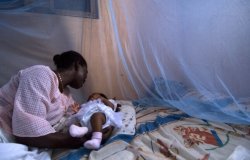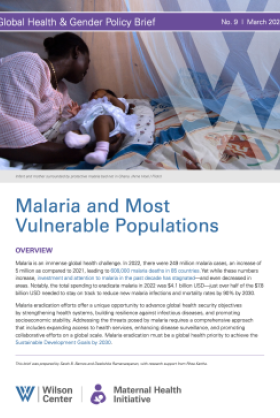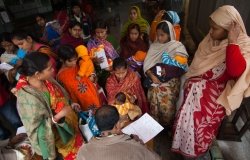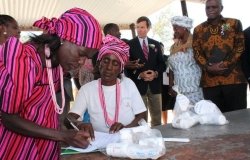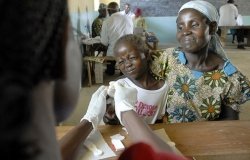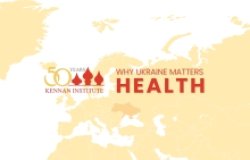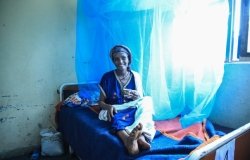Urban Health in Asia: Growing Needs and Challenges Among the Poorest Populations
Panelists discuss the rapid state of urbanization and the health status of the urban poor in Asia and, specifically, in India, where the urban population is projected to expand from 328 to 550 million by 2026, and the urban poor are currently estimated at between 80 and 100 million.
Overview
"Slum and urban populations (are) the fastest growing segments of any country's population, particularly in developing countries," said Siddharth Agarwal, executive director of the Urban Health Resource Centre in India. Dr. Argarwal discussed the rapid state of urbanization and the health status of the urban poor in Asia and, more specifically, India, where the urban population is projected to expand from 328 to 550 million by 2026 and the urban poor are currently estimated at between 80 and 100 million.
There are complex challenges to improving health outcomes for urban populations. Unique factors contribute to ill health in the urban slum environment including irregular employment, illegality of residence, the threat of eviction, regular migration, poor access to water and sanitation, and social issues such as minimal family support and marginalization. All of these factors limit the formation of a healthcare service infrastructure. He described the challenges presented by aggregate data¬—often utilized to compare health indicators between rural and urban populations—noting this data does not explain the significant variations within urban centers, often resulting in the inaccurate conclusion that city dwellers experience improved health outcomes. Based on the data presented by Dr. Agarwal, under-five mortality rates among the urban poor in India are much worse than the average for the urban population as a whole. This trend is also apparent in the rates of childhood undernutrition and decreased access to health services.
The urban population in Asia is growing at a rate of 2.3% per year compared to 0.14% in Europe, relayed Dr. Agarwal. "If you look at the (Indian) census of 1991 and 2001," he explained, "the overall population grew at 2%, the urban population at 3%, the large cities at about 4%, and slum populations grew at 5% to 6%." Although people are drawn to cities by the opportunity for better jobs and a better quality of life, those dreams often go unrealized and the poor populations are increasing more rapidly than the non-poor, said Diana Silimperi,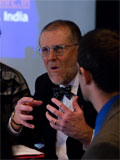 a technical director with the USAID-funded BASICS program who served as a discussant on the panel. Dr. Silimperi added, "this is a unique time in history … fifty percent of the world is urban … and by 2025 two-thirds of the developing world will be urbanized." Dr. Silimperi connected the Indian experience to a larger, world-wide trend, noting that the prospect of rapid global urbanization holds broad sociocultural, familial, and governmental implications. However, even when taking sociocultural differences into account there are transcendent principles that apply to most urban poor populations.
a technical director with the USAID-funded BASICS program who served as a discussant on the panel. Dr. Silimperi added, "this is a unique time in history … fifty percent of the world is urban … and by 2025 two-thirds of the developing world will be urbanized." Dr. Silimperi connected the Indian experience to a larger, world-wide trend, noting that the prospect of rapid global urbanization holds broad sociocultural, familial, and governmental implications. However, even when taking sociocultural differences into account there are transcendent principles that apply to most urban poor populations.
Turning from problems to positive aspects of urbanization, Dr. Agarwal highlighted the opportunities available for advancement in urban areas, noting the ability to affect larger groups of people more quickly, at a potentially lower cost, than in rural settings due to population density. Dr. Silimperi added that urban populations tend to be more heterogeneous, thus creating a more welcoming environment for new ideas and change. There is also more access to communication technology in urban settings, even if each individual is not in possession of a television, computer, or radio. However, she also stressed that although there are many opportunities unique to the urban environment, there remain "geographic barriers" in urban settings, and proximity of services does not guarantee access. Where scarce services are available, the urban poor are often unaware of their presence or unable to access them due to monetary, social, or legal constraints. Dr. Silimperi emphasized the need to step outside of the "health box" and reach out to other sectors—civil society, decision makers, private business etc.—to cooperate for health. Dr. Silimperi sees a need to utilize and enhance the ability of the informal sector to address health issues, by involving factors that are already present, including cultural healers, the unauthorized market of medicine and services, and individual physicians and nurses providing independent services. This is a particularly important part of understanding how delivery of care in urban areas differs from service delivery in rural sectors.
Discussing health advocacy, Dr. Agarwal noted that slum populations often become "invisible," and lack the social capital to bring about policy reform. He believes there has been an increased recognition of the issues facing urban poor among governments, donors, and NGOs. In India, there is a growing presence of NGOs in urban areas and a national task force has been established to address urban health care. He explained three possible models for improvement: an NGO-CBO (community-based organization) partnership approach to enhance demand, supply and capacity, and to foster linkage; a Ward coordination approach to promote convergence among stakeholders, optimize resources, and improve outreach; and finally, an NGO-managed urban health center, which builds public-private partnerships to expand services and social mobilization.
Dr. Silimperi finds there are more similarities between the urban poor in developed and developing countries than between poor and non-poor in the same country. "Issues across cities are the same, no matter where you go," she said. Accordingly, she believes this unfortunate commonality may play a part in initiating future action. Dr. Silimperi pointed to the quantification of the economic impact of urban poor, particularly in the informal sector, as an opportunity for advocacy. According to Dr. Silimperi, the economic contribution of the urban poor is "something we have not capitalized upon." She believes that if the contribution of the urban poor was more effectively quantified it could be used to catch the attention of policymakers. What is important now, said Dr. Silimperi, is the need to "focus our efforts, and get at least one success story out there, that we can use to convince all the naysayers that say you can't make a difference in cities. We have got to do it at scale in at least one place."
The question and answer session touched on the comparative attributes of the growing immigrant populations in the United States and urban poor populations worldwide, the potential for further involvement of university students in support activities in urban areas, and the necessity and shortfalls of leadership in urban health development.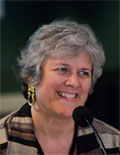 Victor Barbiero, visiting professor at The George Washington University School of Public Health and Health Services, and senior adviser to the Global Health Initiative, moderated the discussion and said, "If you remember little from this (conversation), remember this: what we are talking about today is inevitable, unstoppable. The momentum is there, the world is urbanizing." He referred to an "urban crucible" of colliding factors: chronic and infectious diseases, rich and poor. "These are the kinds of things we cannot ignore if we are to be responsible public health programmers in the future," he said.
Victor Barbiero, visiting professor at The George Washington University School of Public Health and Health Services, and senior adviser to the Global Health Initiative, moderated the discussion and said, "If you remember little from this (conversation), remember this: what we are talking about today is inevitable, unstoppable. The momentum is there, the world is urbanizing." He referred to an "urban crucible" of colliding factors: chronic and infectious diseases, rich and poor. "These are the kinds of things we cannot ignore if we are to be responsible public health programmers in the future," he said.
Drafted by Michaela Hoffman and Julie Doherty.
Speakers
Hosted By

Maternal Health Initiative
Life and health are the most basic human rights, yet disparities between and within countries continue to grow. No single solution or institution can address the variety of health concerns the world faces. By leveraging, building on, and coordinating the Wilson Center’s strong regional and cross-cutting programming, the Maternal Health Initiative (MHI) promotes dialogue and understanding among practitioners, scholars, community leaders, and policymakers. Read more

Urban Sustainability Laboratory
Since 1991, the Urban Sustainability Laboratory has advanced solutions to urban challenges—such as poverty, exclusion, insecurity, and environmental degradation—by promoting evidence-based research to support sustainable, equitable and peaceful cities. Read more

Environmental Change and Security Program
The Environmental Change and Security Program (ECSP) explores the connections between environmental change, health, and population dynamics and their links to conflict, human insecurity, and foreign policy. Read more

Indo-Pacific Program
The Indo-Pacific Program promotes policy debate and intellectual discussions on US interests in the Asia-Pacific as well as political, economic, security, and social issues relating to the world’s most populous and economically dynamic region. Read more
Thank you for your interest in this event. Please send any feedback or questions to our Events staff.
